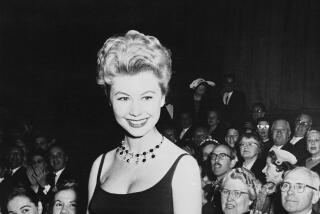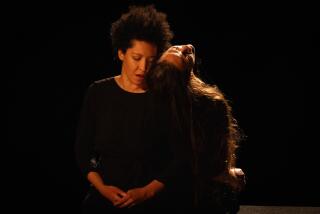Before MTV, There Was Opera : Great stars of the ‘40s and ‘50s are captured in garish glory on videos of ‘Voice of Firestone’ telecasts from TV’s early days
- Share via
In 1949, the popular radio show “The Voice of Firestone” transferred to television and gave the American public a weekly concert featuring some of the most prominent singers of the day. If music lovers, especially younger ones, want to know how it was done almost two generations ago, they need only turn to a series of cassettes by Video Artists International.
In conjunction with the New England Conservatory of Music, which owns the rights to the original kinescopes, the company has released 41 tapes culled from “The Voice of Firestone” programs, which ran live from 1949 to 1963.
The tapes do not offer a simple nostalgia binge, but a chance for everyone to hear and see how some great, near-great and not-so-great artists performed under conditions few of today’s vocalists would endure.
The program, telecast on Monday nights at 8:30 by NBC in black and white, was the brainchild of Idabelle Firestone, music-loving matriarch of the family that owned Firestone Tire and Rubber Co.--and herself a composer. Two of her sentimental songs, “In My Garden” and “If I Could Tell You,” served as sign-on and sign-off numbers of the program and must have earned the composer some decent royalties in a day when conflict of interest and nepotism were less frowned on officially than they would be now.
In the beginning the shows involved little more than concerts, with a format that dictated an aria or two, some “semi-classical” songs (Victor Herbert, Cole Porter, Jerome Kern, George Gershwin and Richard Rodgers were usual favorites) and orchestral solos.
They were mostly presided over by a hack conductor, Howard Barlow. Network officials wanted to replace him from the very beginning, according to Charles Polacheck, the Firestone producer from 1951 to 1957. When it was once suggested that a rising young maestro, Leonard Bernstein, might provide more glamour and musical weight, the word came down from Idabelle that her Howard was not to be messed with. Except for the appearance of an occasional guest, he never was.
Gradually, modest production values began to be introduced, Polacheck stated in an interview a few years ago.
“The whole program was based on the preferences of the Firestone family. It was like a private Monday night music party, which they graciously shared with the rest of the nation.
“It could be difficult, since most of the singers had little or no experience with cameras and the control room was about the size of a broom closet. The fee was a uniform $1,500 for the top vocalists, but the lesser known ones could be had far more cheaply. I never had any trouble with any of them except Jeanette MacDonald, who wanted special camera equipment that only the movie studios used.”
Nothing about the show was lavish except, perhaps, its pretensions. Once sets and costumes (supremely tacky by any standard) were added and an occasional extra were used, the idea seemed to evolve that the more bodies in a shot, the better. There may have been no more than six or eight in the chorus, but sometimes they threatened to bump into each other.
The tapes are not complete shows, but represent an amalgamation of performances over the years. Recent releases featuring the two dominant soubrettes of the Firestone era, Patrice Munsel (VAI 69139) and Roberta Peters (VAI 69140), illustrate the point. Over an 11-year period, Munsel got to do her specialties, particularly the biggest success of her Met career, Adele in “Fledermaus” (“Mein Herr Marquis” sung in English in 1951) and, in 1954, a sensitive “Depuis le jour” from “Louise,” an opera she never attempted on stage.
In the “Butterfly” love duet, from 1961, her voice was developing a wobble, but she showed consummate one-upmanship, when she simply stepped in front of a hapless Richard Tucker for center camera. She also had glamour, knew how to dress and do her hair, and let chorus boys throw her around with abandon.
In 1951, the 21-year-old Peters did not have Munsel’s experience, and it showed. Peters seemed unable to deal with extras around her--she is almost run off the screen by a dancer whacking a tambourine during the “Italian Street Song”--and the voice itself sounded small and immature. She would go on to a career that spanned four decades.
Of other releases, a number are noteworthy for sheer beauty of sound. Leonard Warren (VAI 69105 and 69110) began his broadcasts without the toupee he added almost immediately. His mahogany-colored baritone was used as sensitively in a sea shanty as it was in “Eri tu?” (1951). He also handled a memory slip in the Toreador Song with flair.
Jussi Bjoerling’s tenor (VAI 69101 and 69111) was probably one of the sweetest ever heard. He was not very comfortable with all the girls pushing him around in lighter numbers, but on his own delivered an extraordinarily effortless high C in a silvery “Salut, demeure” (in 1951 he did not yet favor transpositions). The 61-year-old Lauritz Melchior in 1950 (VAI 69107 and 69124) was cause for amazement. His Heldentenor arias are delivered with a secure, stentorian sound probably not heard since, but he could also manage a haunting mezza voce in such lighter fare as the Bach-Gounod “Ave Maria” and “The Student Prince” Serenade.
He also wore some unintentionally funny costumes, including a sou’wester and slicker (Steersman’s Song) that begged for Judy Carne from “Laugh-In” to sock it to him. The great Dane was also the only singer to have his wife appear with him as an extra.
Renata Tebaldi in 1959 and Franco Corelli in 1960 (VAI 69100) were in their prime for their joint tape, the soprano banishing anyone else on camera for her Puccini arias. The fact that they were good-looking was not exactly a hindrance.
Joan Sutherland (VAI 69108), with her youthful brilliance in 1961, dazzled in showpieces of Rossini and Meyerbeer. She was also the only artist to refuse to learn Idabelle’s songs.
Lisa della Casa (VAI 69136), one of the great beauties in Met history, offered some faulty intonation in “Mi chiamano Mimi,” but her tape boasts two “O soave fanciulla” duets: one with Nicolai Gedda (1962) in the original keys, a second with Tucker (1958) transposed downward. She also saw Mimi as something of a fashion plate.
The two leading lyric sopranos at the Met of their day, Licia Albanese (VAI 69104) and Bidu Sayao (VAI 69103) must not have been Idabelle favorites, since they appeared infrequently. The former sang in 1959 with commendable Italianate abandon but was grotesquely costumed. The latter in 1960 was a little past her prime but still mesmerizingly charming as Manon, and able to inflect “I’ll Follow My Secret Heart” with a strange sadness.
The troublesome Jeanette MacDonald (VAI 69118) is a bit pitiful on her tape in 1961. It was her television debut and nerves were evident. Her tremolo-ridden voice was about the same as in movies, but she was uncertain in her movements and unbecomingly gowned.
The singer who held the record for Firestone appearances--47--was Rise Stevens (VAI 69106 and 69123). She had the face, figure and uncanny sense of the camera to tower above the others in effect. Some of her femme fatale poses look a bit old-fashioned today, but there is no question why she was the Carmen and Dalila of her time at the Met.
The oddly underrated Eleanor Steber (VAI 69102 and 69122) followed Stevens in number of appearances: 36. For consistent quality (programs from 1949 to 1954 are sampled here), she ranked at or near the top. Whether in a magisterial “Pace, pace,” an ethereal “Depuis le jour,” a heartbreaking “Addio del passato” or a Rossini “Inflammatus” where those treacherous ascents to the high Cs seemed easy, Steber was surely one of the great American sopranos.
Bitter in her final years, she claimed in a Times interview that it was Stevens’ friendship with Idabelle that pushed her out of the show in its waning days. What no one could tell the lady was that her weight problems and generally tasteless costuming--singers could bring their own--might have had something to do with it.
Now there are no outlets for classical music on commercial television. These cassettes show a kinder, gentler era in America when they were taken for granted.
More to Read
The complete guide to home viewing
Get Screen Gab for everything about the TV shows and streaming movies everyone’s talking about.
You may occasionally receive promotional content from the Los Angeles Times.






